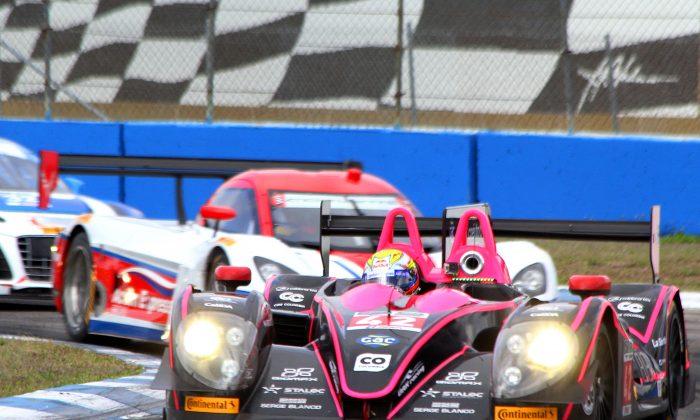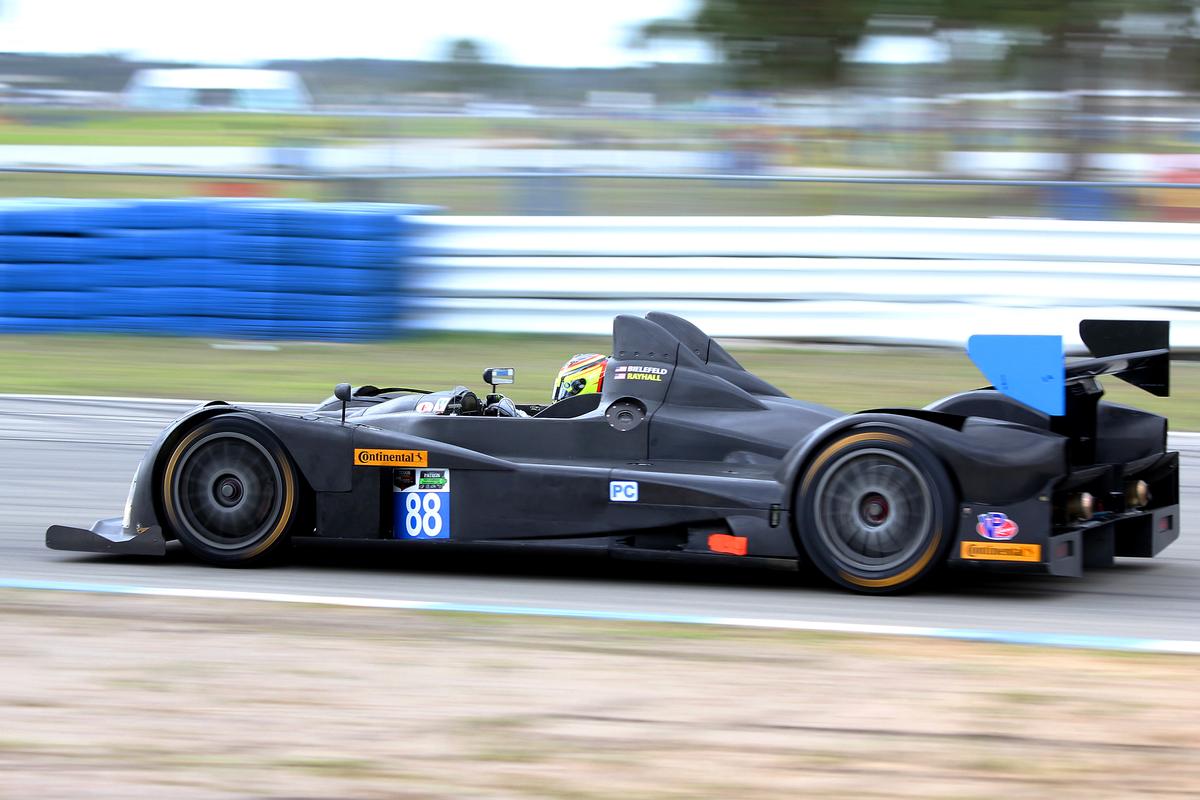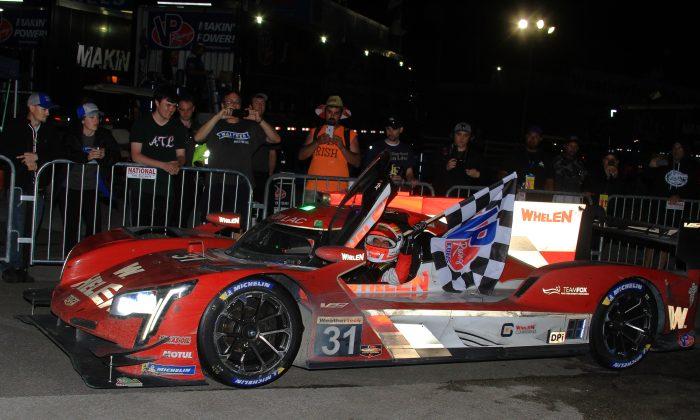SEBRING, Fla.—The Tudor United SportsCar Championship Sebring Winter Test showed how the new merged sports car series comports itself on a real road-racing track, and the results were wholly positive.
Forty-two cars showed up to test at North America’s most iconic road circuit—a dozen Prototypes, four PCs, eight GTLMS, and 18 GTDs.
The two-day test proved a lot of things—most important being that the premier Prototype class, composed of two radically different types of cars, can be made to work on a natural-terrain road course.
TUSC’s Prototype class is composed of Daytona Prototypes—originally simple, heavy, tube-framed, V8 -powered cars with primitive aerodynamics—and P2s, originally Le Mans-compliant LMP2 cars with modern carbon-fiber monocoques, a variety of stock-based motors, and the latest aerodynamics.
DPs were designed to be simple, rugged, and cheap to own and operate. P2s were designed to be quick, and while the engine and chassis were cost-capped, spares and replacement parts might have been a bit steeper.
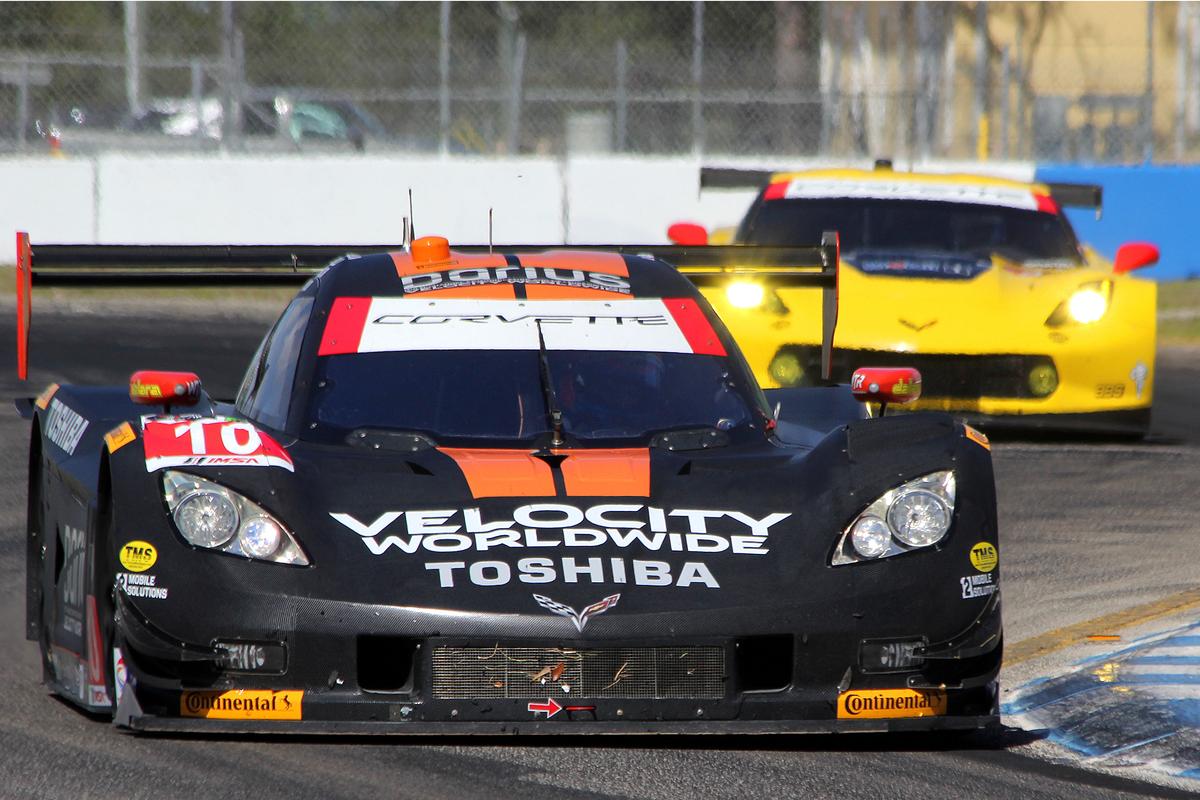
The #10 Wayne Taylor Racing Dallara-Corvette leads one of the Corvette Racing C7.Rs through Turn 11. (Chris Jasurek/Epoch Times)
DPs were generally a few seconds slower than P2s at any track where both types of cars raced—and many people thought that was an unbridgeable gap.
DPs have been allowed a wider variety of engines, including turbocharged V6 options from Ford and Honda, while also receiving an array of mechanical and aero upgrades, including carbon brakes and paddle-shift gearboxes.
Upgrading the DPs was expensive—no reliable figures have been released but a reasonable estimate is between a quarter and half-a-million dollars. The finished product is worth the price, though.
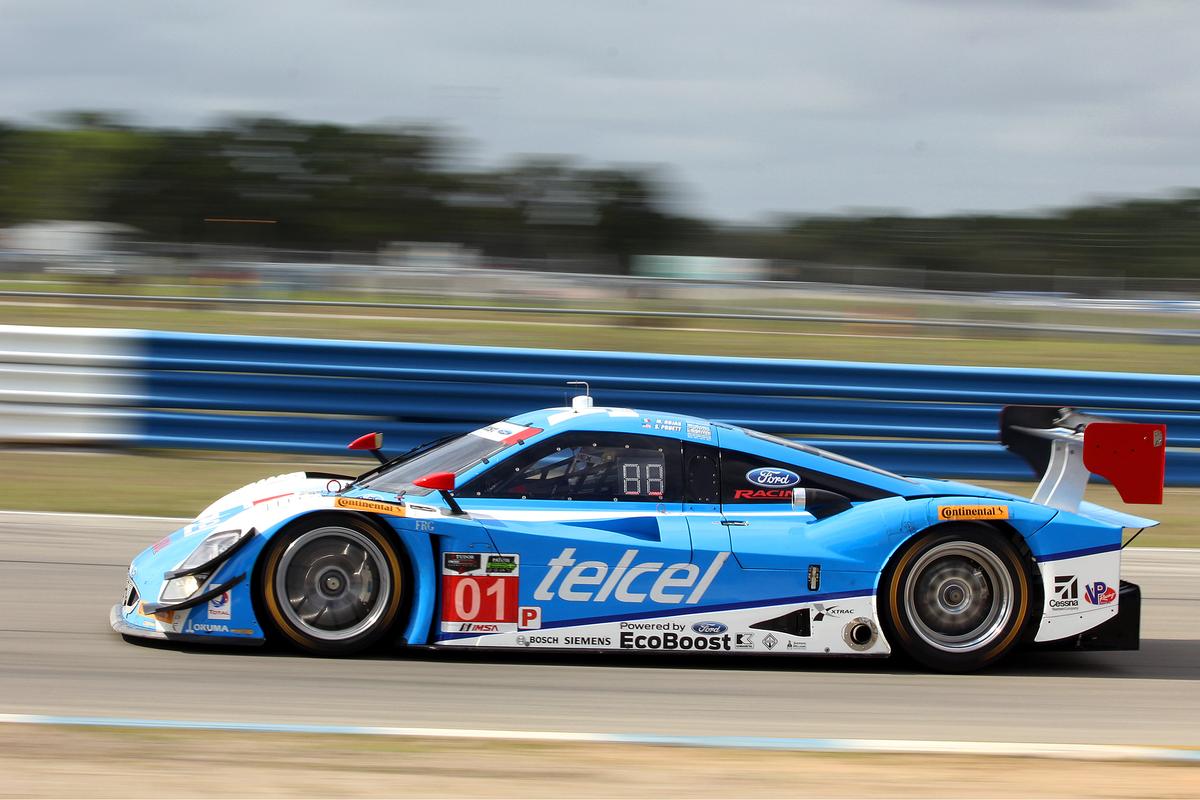
IndyCar champ Scott Dixon showed up Friday afternoon and pushed the #01 Ganassi Riley-Ford DP to its best lap of the test. (Chris Jasurek/Epoch Times)
Daytona Prototypes with the new aero additions (extra dive planes, side pods, and rear diffuser) are as quick around Sebring as P2s. Times around Sebring’s 3.74-mile, 17-turn track were comparable—in fact, the gaps between cars was pretty similar to the spread at Daytona.
The DPs have at least 100 more horsepower, offset by the fact that they weigh about 300 lbs. more. The P2s make a little more downforce. Sebring is notorious for its big bumps and variety of surfaces, but both types of cars were able to negotiate the course with no apparent difficulty.
Can the DPs hold up under the pounding for 12 hours? Twelve hours at Sebring is going to be much harder on the chassis than 24 at Daytona—but Daytona brings its own special stresses, with huge pressure on the suspension through the banking. Also, DPs have run for six hours at Watkins Glen and two hours at the equally bumpy Belle Isle circuit with no particular problems.
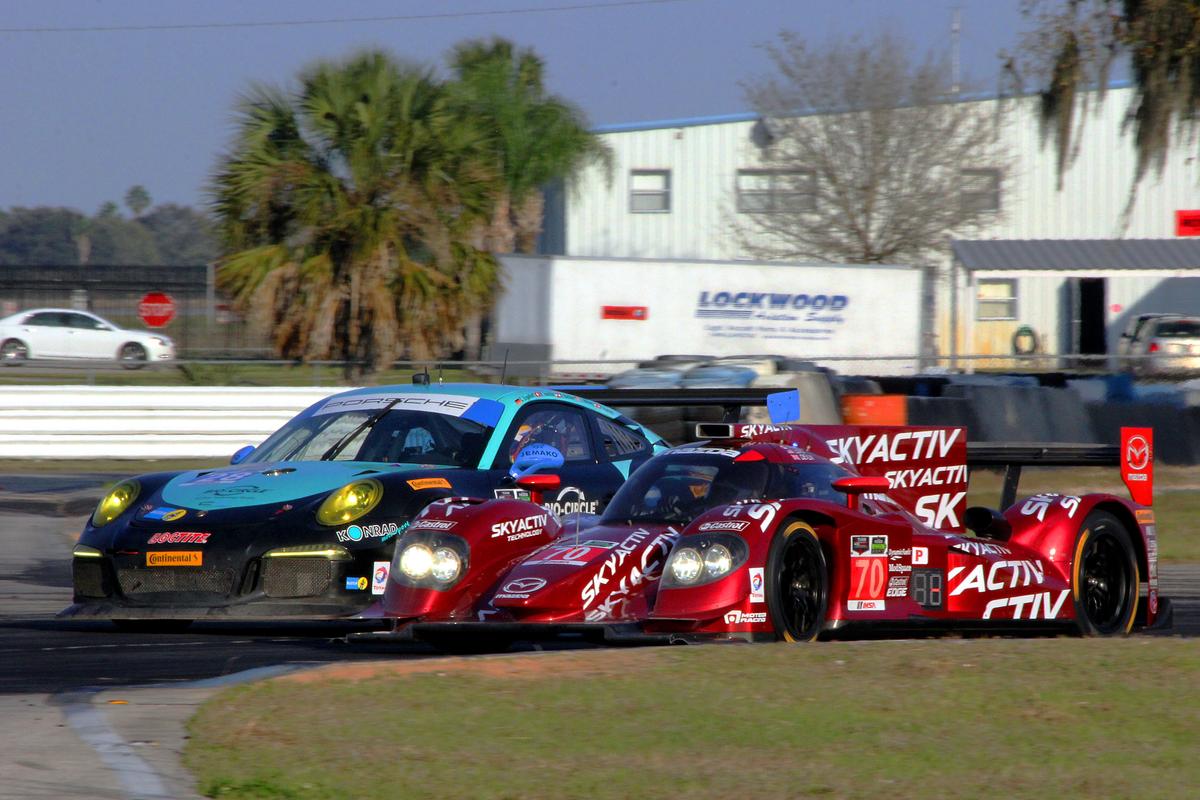
The #70 SpeedSource Mazda SkyActiv diesel P2 squeezes inside the #28 Dempsey Racing GTD Porsche at Turn Five Thursday afternoon. (Chris Jasurek/Epoch Times))
Some have speculated that P2s might not hold up as well in the cut-and-thrust of competition for corners compared to the DPs, but there is no evidence that the DPs are really tougher—maybe their sleeker bodywork will be less prone to getting ripped off, but with the new diffusers dual diveplanes, DPs still have fragile bits exposed.
The P2s are proven quantities at Sebring–in fact a P2 Porsche won overall against Audi’s all-conquering R10 in 2008. There is no question that they can race hard for 12 hours and absorb everything Sebring can dish out. Whether they can find the little bit of speed they lack to the DPs is a bigger issue—the horsepower differential might be a little bit too much to overcome with just a few hundred pounds weight break.
It is essential that TUSC get the balance perfect. There are teams in the series considering expanding and there are others teams, many overseas, considering racing in North America. No team wants to invest heavily in machinery which won’t be competitive.
So far, the fastest DP has consistently been seven- to eight-tenths quicker per lap than the quickest P2, at both Daytona and Sebring. Enough laps have been run under enough conditions to validate the data. Competition VP Scot Elkins might need to look at dialing back the DP’s horsepower by a tiny margin to achieve absolute parity.

The #911 Porsche North America RSR leads the #19 Muehlner Motorsports Porsche 911 GT America through Turn Ten Thursday morning. (Chris Jasurek/Epoch Times)
GTLM: Porsche Is Back in Force, but Everyone Else Is Close Behind
In 2012 Porsche introduced the latest version of its 997-based 911 GT3 RSR; the new car did not get rave reviews. The new, sleeker, higher-downforce bodywork and wider track left the new car hard to balance. Eventually teams got a handle on the new chassis, but it was never a world-beater.
Porsche brought its new 991-based 911 RSR to Daytona and was immediately quick, winning the GTLM class at the Rolex 24. The new cars came to Sebring and topped the GTLM timesheets in every session, finishing first and third twice and top two twice.
The Porsche North America 911 RSRs were the only GTLM cars to run sub-two-minutes laps, both turning laps at 1:59 in the final session. After the engineers at Porsche’s Weissach Motorsports Center crunch the numbers, the cars will likely come back even quicker for the Sebring Twelve Hours March 12–15.
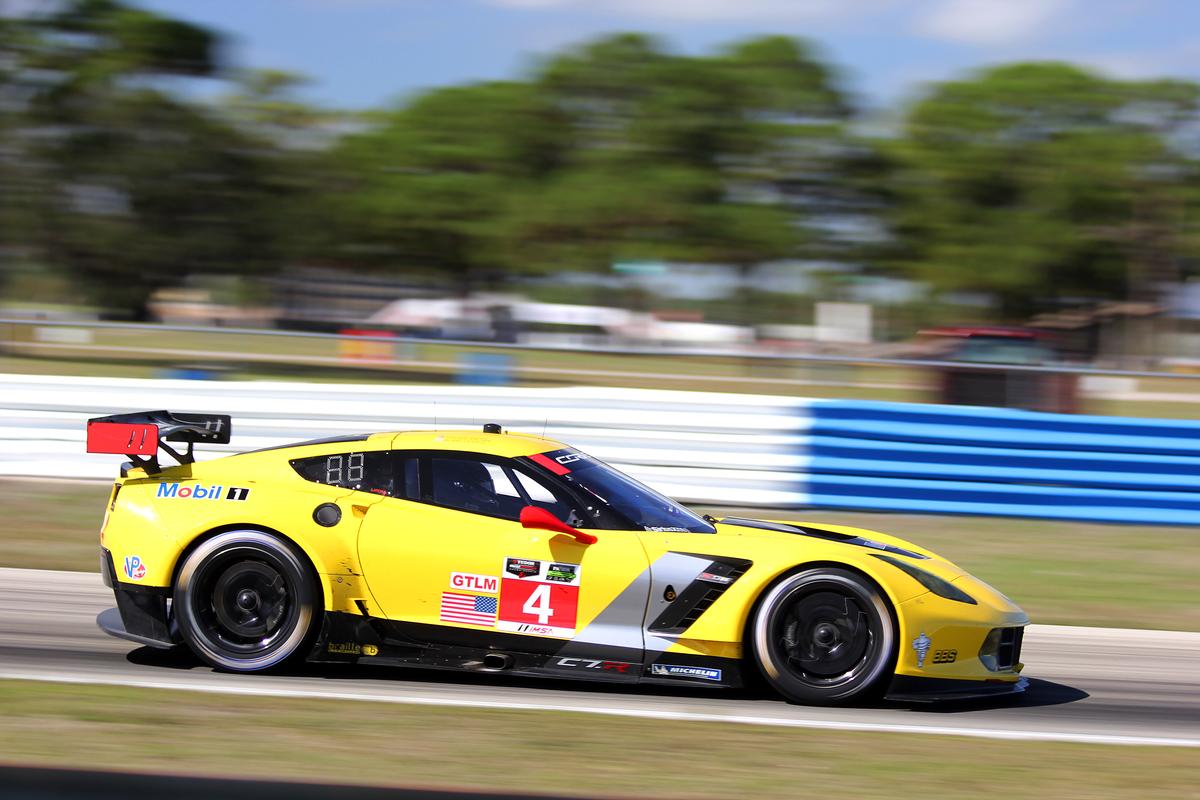
The #4 Corvette Racing C7. R heads for Turn Three Thursday morning. (Chris Jasurek/Epoch Times)
While Porsche is back as a dominating force in the GT ranks with its latest car, the factory won’t find it easy to stay on top.
GTLM, which was imported unchanged from the American Le Mans Series continues to offer amazingly close competition. The factory-supported Corvettes, Vipers, Ferraris, and BMWs are all about as quick. Gaps between the top five GTLMs in the first three sessions averaged 0.733 seconds.
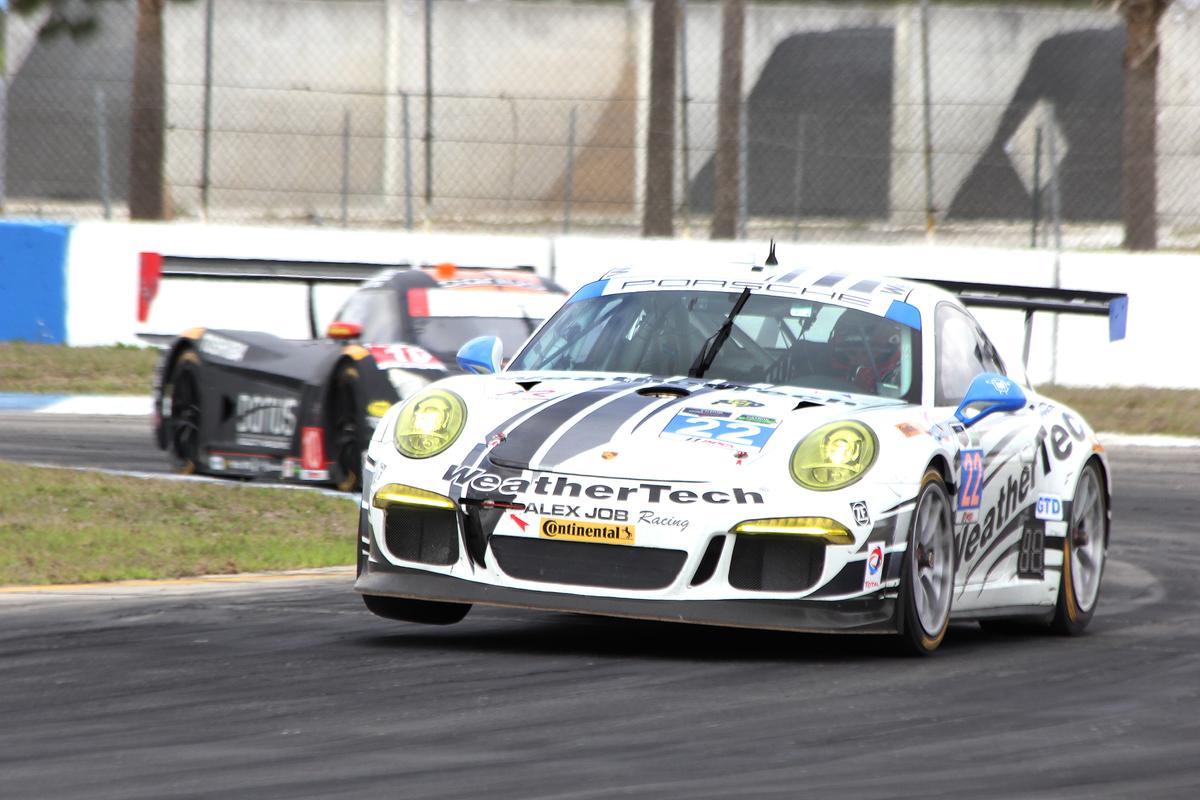
The #22 Alex Job Porsche tries to wheelie around Turn Ten. (Chris Jasurek/Epoch Times)
GT Daytona
The GT Daytona class is miles ahead of the old American Le Mans Series GTC class, and better even than the Rolex Sports car Series GT class.
The old ALMS GTC class was basically a field-filler—cars from a single-make support class allowed into the big show when car counts were low. The Rolex GT class offered good competition but the cars couldn’t match the ALMS GT class.
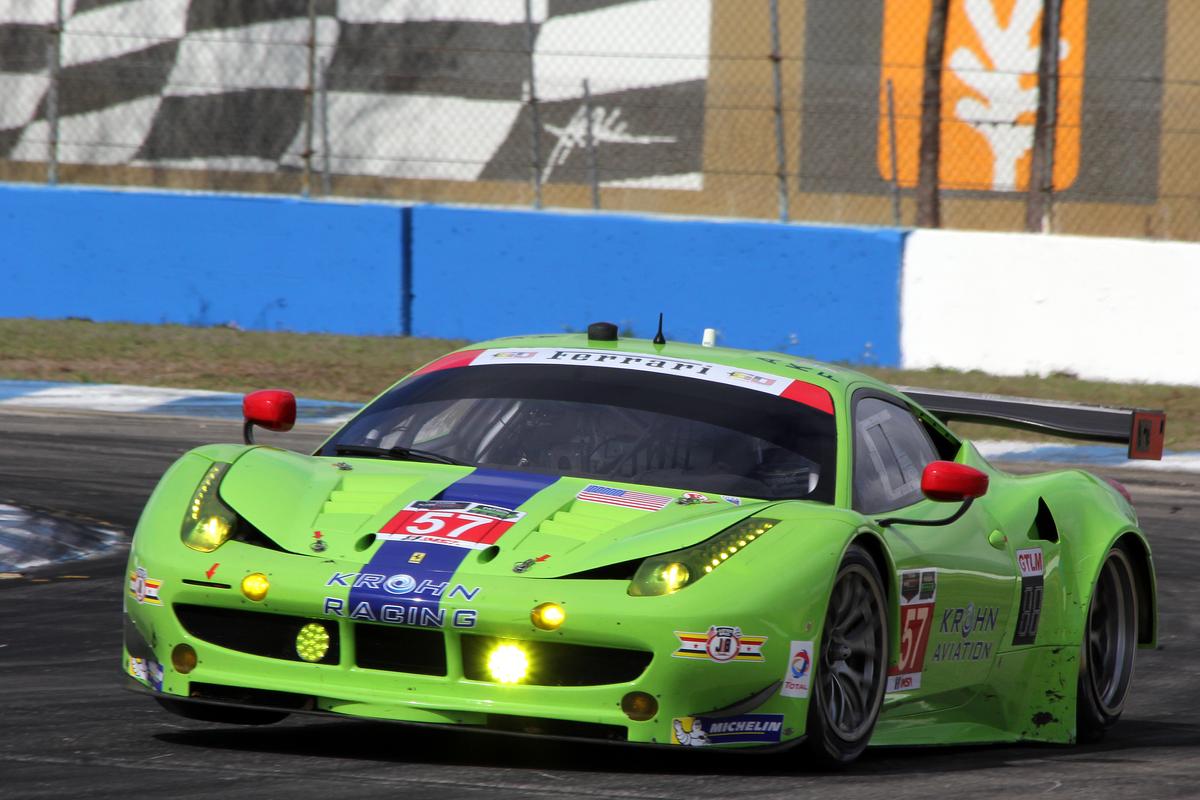
The #57 Krohn Racing Ferrari 458 proves that not only Porsches can lift a wheel around Turn Ten. (Chris Jasurek/Epoch Times)
The new GTD class is a serious GT battlefield: the best Rolex GT teams with the added attraction of some excellent ALMS teams. The variety in GTD is as great as in GTLM—Porsche, Ferrari, SRT Viper, Aston Martin, BMW, Porsche, and Audi are all represented—and the competition is as close. In all four sessions the slowest GTD car was within four seconds of the quickest—in an 18-car field.
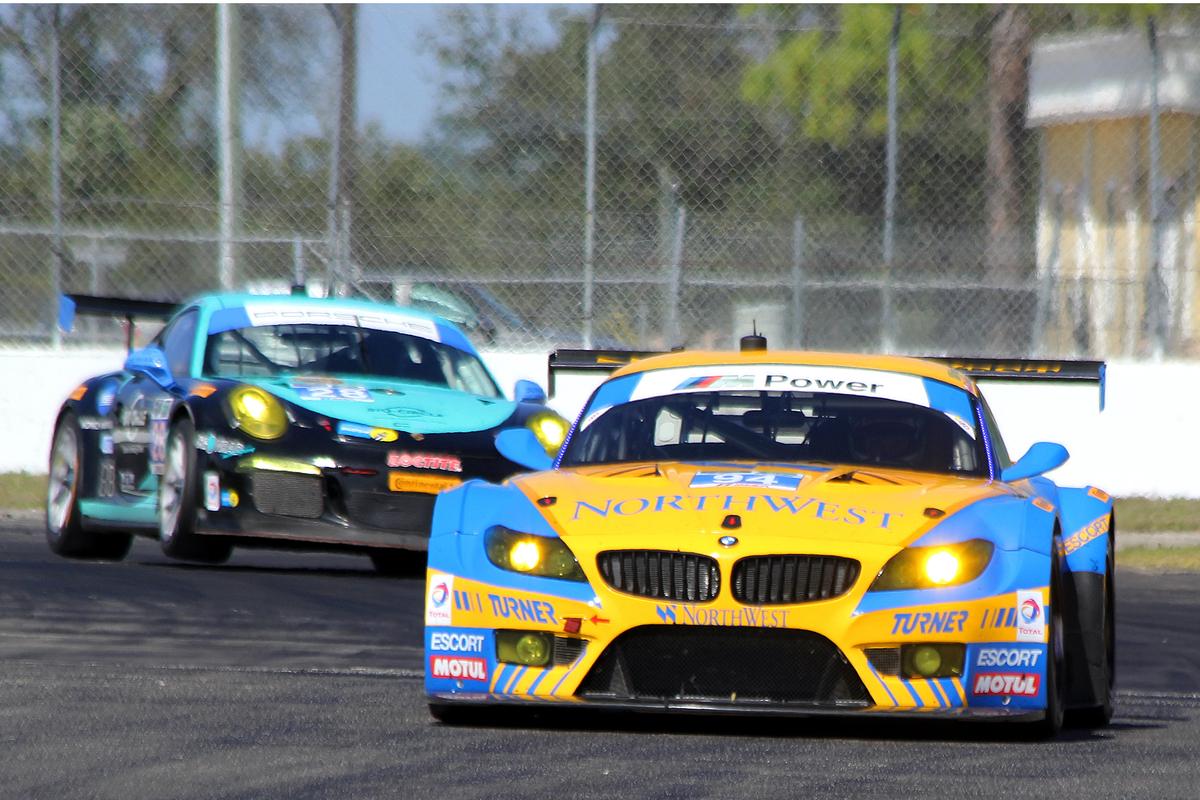
The #28 Dempsey Porsche (L) gets two wheels off the ground as it chases the #94 Turner Motorsports Z4 GTD around Turn Ten. (Chris Jasurek/Epoch Times)
GTD might be the slowest class on track, but it brings as much to the series as any of the other classes—there is an abundance of good racing here
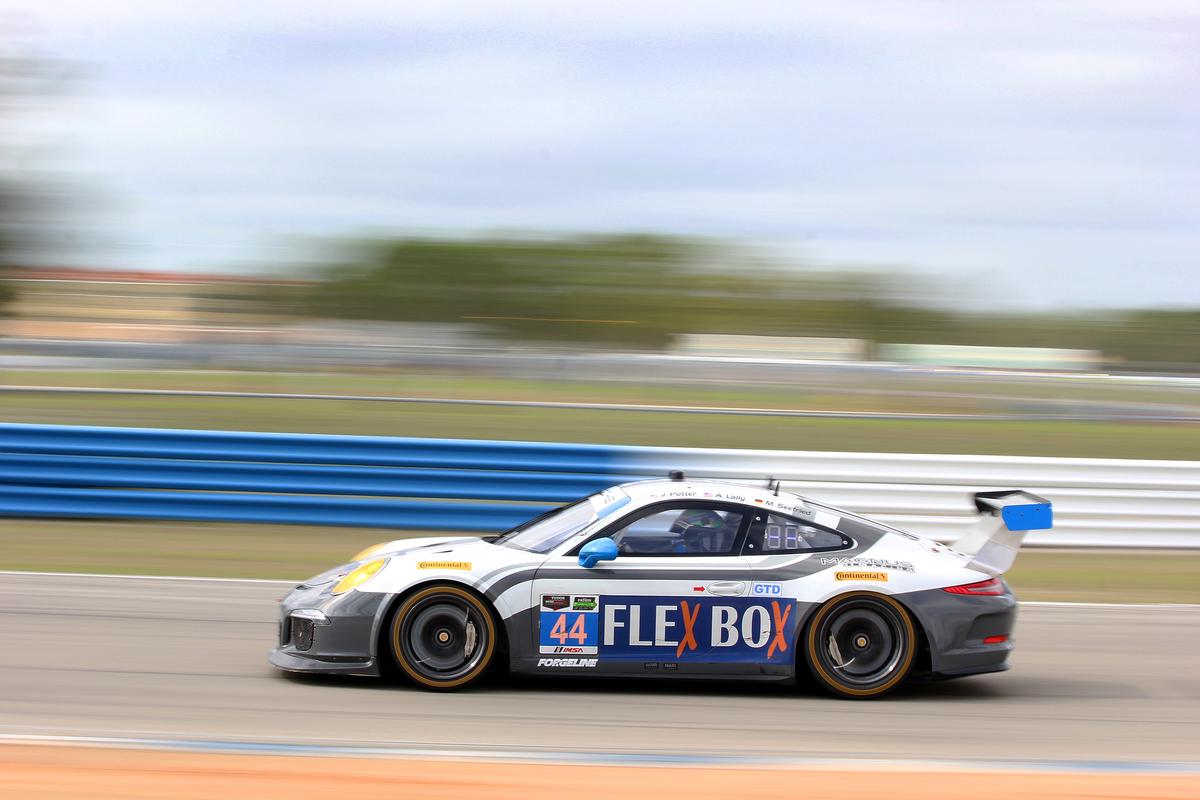
The #44 GTD Magnus Porsche streaks towards Turn 11 Friday morning. (Chris Jasurek/Epoch Times)
Porsche was a powerful force in GTD as in GTLM. The #73 Park Place 911 GT America topped two of the four sessions, and Alex Job #22 Porsche was quickest in the final session. The #007 Aston Martin Racing Vantage V12 was quickest in the first session and fourth in the next two, with the #44 Magnus Porsche, #33 Riley SRT Viper GT3-R, #94 Turner BMW Z4, #45 Fling Lizard Audi, and the #51 Spirit of Racing Ferrari taking turns in the second and third slots.
TUSC Faces Challenges
After the win by Action Express at Daytona, a lot of sports car fans said the win was predictable—of course new series owner NASCAR was going to give a performance edge to its favorite cars, the DPs, at its home track. While the performance of the two types of prototypes was close, undeniably the DPs had an edge at Daytona. The DPs seem to have a similar edge at Sebring.
Competition VP Scot Elkins needs to think long and hard about ways to make the two types of cars even more equal. The Rolex 24 was the Rolex Series’ premier event, and one of the few which actually attracted fans. For a DP to win there was no real problem for the series.
It would similarly be no problem for the series for a DP to beat the P2s at Sebring, the most important ALMS race—so long as fans had to admit the DPs won a fair fight. There absolutely needs to be a level playing field—if ex-ALMS fans (which far outnumber ex-Rolex fans) even think they can sense the slightest bit of favoritism for Daytona Prototypes, the series could lose a lot of supporters very quickly.
Oak Racing has consistently shown itself to be the fastest P2 team, and it has consistently run about .75 seconds behind the quickest DP, the Action Express #5.
While at Daytona a certain amount of leeway could be granted because the P2 teams were on a strange track with very unusual set-up requirement and were also learning a brand-new tire, at Sebring the P2 teams pretty much know the score. If the Oak Morgan Nissan can run a best lap of 1:53.204, that is likely the best lap a P2 can run at Sebring on the Continental tires. That is borne out by the remarkable consistency of the Oak car’s lap times: only 0.134 variance in 1654 laps across all four sessions.
The #5 Action Express Coyote-Corvette only ran two sessions flat-out for a total of 90 laps, and the times from the two were only 0.008 seconds different. One could reasonably surmise that the car’s best lap of 1:52.48 is about the best a DP in the current configuration can run there.
That gap of about three-quarters of a second may seem insignificant, but over 350 laps of racing it adds up to a lap-and-a-half advantage.
It makes no difference if a DP or P2 wins at Sebring. The only thing that matters is that the winning car earned the victory against equal opponents on a level field of play.
Media Matters
TUSC faces two significant challenges in presenting the Sebring 12 Hours to its television audience.
One is that there will be so much excellent racing happening all over the track that the director and announcers will need to be incredibly aware and responsive, without resorting to short-take jump-cuts which create a kaleidoscope of meaningless images.
There will likely be intense battles all through each of all four classes, most particularly in the tow GT classes. The TV director will have to follow all these fights and make sure the fans get to see them—follow-the-leader can be deadly boring over 12 hours, but there is hardly a dull moment if the director watches the whole track. Watching a battle for fourth in class is better than watching the leader circle unmolested.
At the same time the director needs to stay with each battle for a lap or two—cutting quickly to a car about to pass another and then cutting away in two or three seconds whether there is a pass or not is just confusing.
It may seem strange to the uninitiated, but for sports car fans, watching one car trying to pass another is as good as watching a pass. Passing isn’t like scoring a goal or hitting a home run—often the excitement lies not in the actual pass but in the attempt.
Counting passes like counting points in some other sporting event misses the point entirely—two cars can battle for an entire race and the race can be edge-of-your-seat, hold-your-breath exciting even if the two cars never change position.
The director needs to show these battles develop, follow them a while, and then look for new ones. The announcers likewise need to know which cars are cutting through the field, which are fighting over position, and be able to comment when the director cuts to those fights.
That way when a fan sees that some car has advanced in the running order, he or she will recall seeing the car making the effort. It gives the running order some meaning. It gives the race its interest.
About the announcers: they have to actually understand sports car racing. They have to know the drivers and the teams, and they have to be able to analyze timing and scoring and the various video feeds and understand what is happening on track.
Repeating the running order every five minutes is a waste of airtime—who can possibly remember the precise running order from five minutes previously? The announcers need to tell the fans which cars are moving up, falling back, pitting off schedule, due to pit—the information which allows viewers to understand the race. There is a lot more to the sport than which car is in the lead.
A lot of people poked fun at the MRN crew for mispronouncing drivers’ names during the Rolex 24 broadcast. That is insignificant. Likely only the drivers and others who speak their native language with the same accent pronounce those names properly. What the announcers need to be able to do is provide information to enrich the viewers’ experience—which means the announcers need to know what information will enrich the viewers’ experience.
Easy to Succeed, Hard to Fail
TUSC is in a very strong position. With a full field of 68 top-quality cars entered for the Sebring 12 Hours, and very close competition between the cars in each class, it should be easy for TUSC to present a Sebring 12 Hours as good as any other in the 62-year history of the race.
A tiny tweak to the DP/P2 balance should perfectly equalize that class. GTLM and GTD are perfect as is. PC is pretty much unnecessary at this point but the cars are still quick and loud and run by skilled teams—the C cars don’t detract from the overall event.
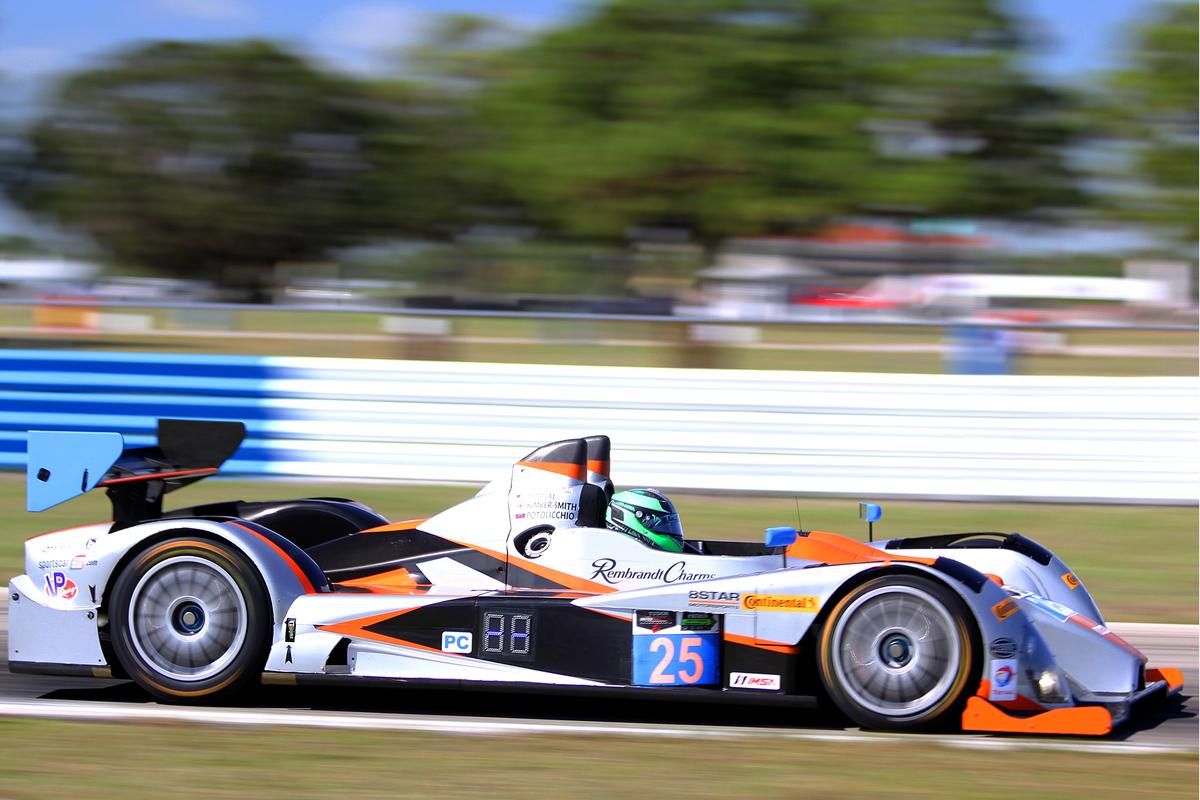
The #25 8Star Oreca was quickest PC in both sessions Thursday and set fastest PC lap of the test, despite spinning off track in both sessions. (Chris Jasurek/Epoch Times)
- The #88 Bar1 Motorsports Oreca-Chevrolet was quickest in the PC class Friday morning. (Chris Jasurek/Epoch Times)
The #88 Bar1 Motorsports Oreca-Chevrolet was quickest in the PC class Friday morning. (Chris Jasurek/Epoch Times)
The media presentation needs to be upgraded from Daytona, but since the race is only half as long, it shouldn’t be hard to hire enough knowledgeable staff to announce the event, and emphasizing following the action versus following the leader is nothing new—it just needs to be out into practice throughout the race.
TUSC would have to make a concerted effort not to get this race right. Manipulating the final result with spurious caution flags could ruin it; not making the most of the TV/online audience would hurt.
Otherwise, TUSC is golden. TUSC is bringing a packed field of quality cars to the continent’s most prestigious and longest-running sports car endurance race; a quality experience is almost guaranteed.
For more information about the 62nd Sebring 12 Hours, visit IMSA.com. Tickets, for the whole four days, camping, paddock access, or just race day, March 15, are available through the Sebring Raceway website.
